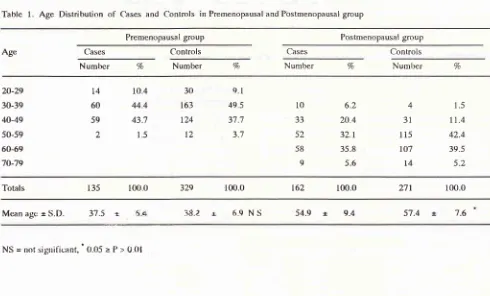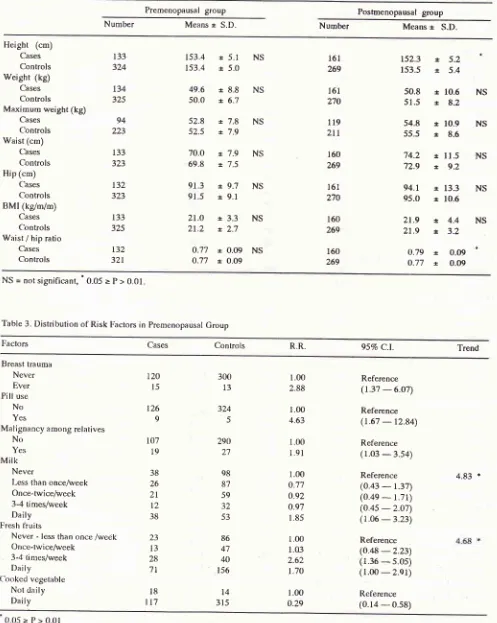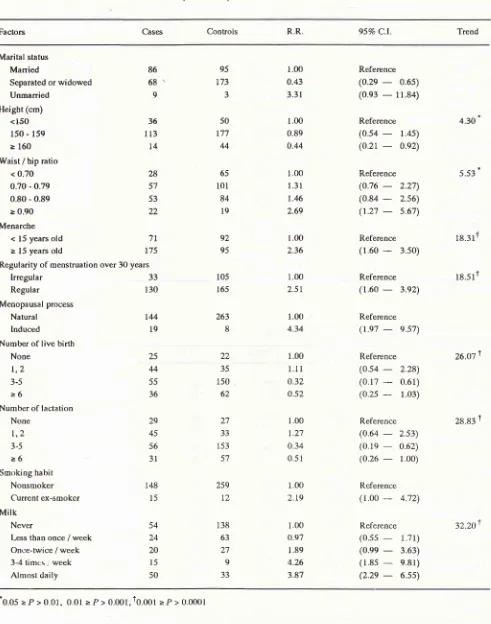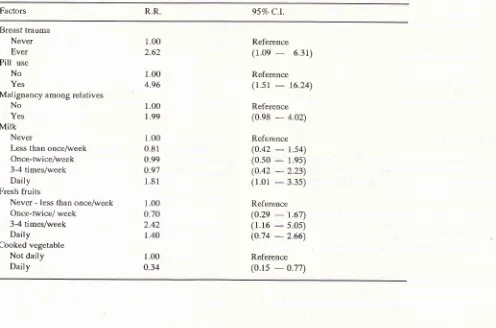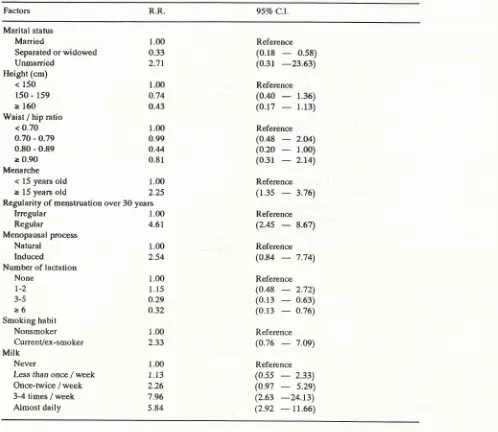Epidemiologic Risk Factors for Breast
Cancer
Related
to
Menopausal
Status
in
Indonesia
i,""iï:ï.'JIj|,:_l;*,1,:Xôffi],",",',,îffilïii",'#îil:ffJi:ïi.',',';,ffïllffir:'i"::ï::h?rîiË:''
Esti
Soetrisno+, EudangSri Roostini*
Abstrak
Untuk meneliti faktor risiko kanker payudara yang berkairan dengan status menopause, dilakukan penelitian kasus kontrol pada rumah sakit
di
Indonesia'Pada
300
kasus dan 600 kontrol yang berpasantan menurut umur dan keadaan sosial ekonomi dilalatkan wareancard' Kasus dan kontrol dikelompokkan berdasarkan slatus menopausenya dan dianalisis terpisah. Diperoleh lemuan-temuan bermakna berikut ini. Di antara penderita kanker payudara pra menopauie ditemukan peningkatan risiko pada yang mengalami trauma payudara (RR:2,62; 95voIK: 1,09-6,31), menggunakan kontrasepsi
oral
(4,96; 1,51-rc:24, mengkinsumsi susu (1,g1; 1,01-3,35 konsumsipenuruna
minggu)'Di
antara
iap hari)'15 tahun
atau
lebih
g,6l
g4; 2,92-11,66, konsumsi tiaphari versus nir konsumsi). Penurunan risiko ditemulan pada wanita
yang
5g), jumlah melahirkan hidup atau bayi yang disusuinya tinggi (0,32; 0,13-0,76), menyusui 6 atau lebihAbstract
a hospital-based case-control study was ls were selected, matching
for
age and tus and analyzed separately. Following s detected in women with breast trauma 1-16.24), milk consumption (1.g1;j.0l-3.35,
daily intake vswith cooked-veserabte intake (0.34;0.1s-0.77, dairy inrake vs not daity
t"i:;:l:;*';::P;"â::::îï:::Ï::::::tî:::,'::.:i::r
was founcl in women having menarche at the age of 15 years or over (2.25; 1.35-3.76), regular menstruation after thirty years old (4.61;
2'45-B
(0'33;
umption (5'84; 2.92-11.66, daily intake vs no intake), and a decreaseâ risk inwomenwhowere divorced orwidowed d whose number of live birth or breast-fed children was high (0.32; 0.i3-0.76, six or more breast-fed childrenvs
no bre
Keywords i case'conlrol
sludy, premenopausal women, post menopausal women, breast cancer, risk factorsDeparlment of Preventive Medicine, School of Medicine Nagoya _ Llniversity, Nagoya 466, Jupan
| [)epartment of Commrmitl,Med.icine, Focttlty of Medicitrc, UttiversiA _ oflnd.onesia, Jakarla 10320, Indonesia
+ Departmeil of Analomic Pathologt, Faculty
of Medicine, Iltriversity . oflndonesia,Jaka a
s Research Center, ine, IJniversily
of Indortesin, ,,J t ka rla I 01 30, I ndot rcsia
tlDeportmetil of Public Health, Medical
School, Nagoyt City lltriver-. sity, Nagoya 467, Japatt
' Deparlment of Surgery, Faculry of Medicine, IJtiversity of Indotresia, **Jaka rta I 01 j0, I ndoncsia
Departmcnt of Surgery, Catrcer Iustihtle Hospiral, Tol<-vo 170, Japntr
Risk
factors
of
breast cancer
(BC)
have
beenwidely
discussed,
and different etiologic factors
have
been suggested related to rnenopausalstatus.l-6 BC
risk has
been
reported
to
be negâtively
associated
with
thenurnber
of
pregnancies. This protective effect
mayapply
only to
wornen whose
BC
was diagnosed at
50 years orolder.'
A
few
studies suggest thatparity
may be associatedwith
an increased
risk of BC in
yourrg wolnell.S-9Iu
posttrrenopausalin
-l7O
Suankietal.
MedJ Indones
Cipto Mangunkusumo Central
Hospital, University of
Indonesia, 135 and 163 patients were at premenopausal and postmenopausal status respectively. Two patients were atunknown
menopausalstatus.
The agedistribu-tion
of cases
and controls
is shown
in
Table
1. Postmenopausal cases were significantly younger thantheir
controls
(54.9 vs. 57.4
years
old),
whereas
premenopausal
cases were nof significantly so(37.5
vs. 38.2 yearsold). Table
2 shows the mean andstand-ard
deviation (SD)
of
height, weight
and
obesity
in-dices asBMI
andwaist
/
hip ratio.
In postmenopausal
wornen,
controls
were
significantly taller
by
1.2
cm,
and
slightly smaller
in
waist
/
hip
ratio than
cases.Excluding
thesedifferences,
noother
significant
case-control differences were found
in
both
premenopausal and post-menopausalstudy
subjects.Table
3
shows
the
RRs
of
breast cancer
in
pre-menopausal
women
obtained
by
univariate
analysis.Breast trauma and the
use of oralcontraceptives
sig-nificantly
increased
the risk. History
of malignant
neoplasm arnong
relatives (mother,
aunts
or
sisters) increased therisk by 9I7o, though
the increase wasnot
significant.
The
risk
increased
with
increasing
rnilk-intake aud amount of freshfruits
consumed;significant
linear
trendswere
found
(chi-square
for
trend
-
4.83,
P<0.05 and 4.68, P<0.05respectively).
Daily
intake
of
cooked vegetablessignificantly
decreasedthe risk.
creased infirst-degree relatives
of premenopausal
BC
patient,
but
not
in
relatives
of postmenopausal
BC
patients.r l,actation
showed protective
effect against
premenopausal
BC alone.''o
The
studiesexemplified
above
strongly support the idea that premenopausal
worneu
differ
from
postmenopausalwomen
concern-ing
BC risk
factors.
In view
of
the abovedifferences,
we haveanalyzedthe
risk
factors
in
prernenopausal
and post menopausal
wornen separately
in
this
paper.METHODS
Methodological
details of the casecontrol
study designand data
collection
were already described
in
thepreceeding
paper.
In
this
paper,
casesand controls
were groupedaccording
totheir
rnenopausal status andwere analysed
separately.
Relative
risk
(RR)
with
its
957o
confidence interyal
(CI),
computed
as the
ex-posure-odds
ratio, was
used as
a meâsure
of
the
as-sociations between potential
risk
factors and
BC.
Trends were
evaluatedby
theMantel extensiou
test.l2To
account
for
age, socioeconornic class,
residenceand
other
variables
potentially
confounded,
uncondi-tional logistic
regressiouaualysis" was
performed.
RBSULTS
[image:2.595.63.553.466.762.2]Out
of
300 histologically diaglosed
BC
patients
ex-amined
from December
1988
to
November
l99l
atTable l.
Age
Distributiono[ (hses and
Controls in Premenopausal andPôstmenopausal groupAge
Premenopausal group Postmenopausal group
Cases Controls Cases Controls
Number Vo Number % Number % Numl>er %
20-29 30-39 40-49 50-59 60-69 70-79
10.4 44.4 43.7 1.5
30 r63 124
l2
I.l
49.5 5t-l3.7
6.2 20.4 32.r 35.8 5.6
4 3L 115 ro7
t4
1.5
tt.4
42.4 39.5 5.2l4
60 59 2
l0
55 52 58 9Totals 135 100.0 329 100.0
t62
100.0 271 100.0Mean age
t
S.D.37.5
t
NS = not sigrrificant,' 0.05' P > 0,01
Vol 4, No 3, fufu - September 1995
Table
2. Mean Vatues of Height,
Weight and Obesity lndicatorsMenopausal Slatus
t7t
Premenopausal group Postmenopausal group
Number Means
r
S.D. Number Meanst
S.D.Height
(cm)Cases
Controls
weight
(kg)Cases
Controls
Maximum weight (kg)
Cases Controls Waist (cm) Chses Controls Hip (cm) Cases C-ontrols
BMI (kg/m/m)
Cases
Controls Waist
/
hip ratioCases Controls t33 324 134 325 94 223 133 323 132 323 t33 325 132 321
153.4
t
5.1153.4
t
5.049.6
r
8.850.0
t
6.752.8
t
7.852.5
*
7.970.0
t
7.969.8
x, 7.591.3
*.9.7
91.5
r
9.121.0
*. 3.321.2
x. 2.70.77
=
0.09O.77
r
0.09*
5.2t
5.450.8
r
10.651.5
*,8.2
54.8
r
10.955.5 t
8.674.2
t
ll.5
72.9
t
9.294.1
r
13.395.0 t
10.62t.9 27.9 NS NS NS NS NS NS NS NS NS NS NS NS 161 269 161 270 119
2tl
t60 269l6l
270 160 269 160 269 152.3 r53.5*
4.4t
3.2O.79
r
0.09O.77
*
0.09 NS = not significant,' 0.05 > P > 0.01,Table 3. Distribution of Risk Factors in Premenopausal Group
Factors Cases Controls R.R. 95Vo C.l. Trend
Breast trauma Never Ever
Pill use
No Yes
Malignancy among relatives No
Yes
Milk
Never
Less than once/week Once-twice/week 3-4 times/week
Daily
Fresh fruits
Never - less than once /weél( Once-twiceÂveek
3.4 tintes/week Daily
(looked vegetable Not daily Daily 120
l5
126 9to'l
l9
38 262l
l2
38 23l3
28 7tl8
tt7
300l3
324 5 290 2't 98 87 59 32 53 86 47 40 156 14 315 1.00 2.88 1.00 4.63 1.00 1.91 r.00 0.77 0.92 0.97 1.85 1.00 1.03 2.62 1.70 1.00 o.294.83
I
Reference (1.37
-6.07)
Reference (1.67
-
12.84)Reference (1.03
-
3.54)Relerence (o.43
-
t.37)
(0.4e
-
l.7l)
(0.45
-2.07)
(1.06-3.23)
Reference (0.48-2.23)
(1.36-
5.05)(1.0o
-
2.sl)
[image:3.595.54.551.96.719.2]172
Suzaki
et al.Table 4. Distribution of Risk Factors in Postmenopausal Group
Med J Indones
Factors Cases Controls R.R. 9s% c.r. Trend
Marital status
Manied
Separated or widowed Unmarried
Height (cm) <150
150 - 159
> 160
Waist / hip ratio
< 0.70
o;lo
- 0.79 0.80 - 0.89È 0.90 Menarche
< 15 years old > 15 years old
86
68.
9 36 1t3 L4 28 57 53))
7L 175 33 130 r44 t9 25 44 55 36 29 45 563l
148l5
54 24 20l5
50 95 173 3 50 t77 44 65 101 84 19 92 95 105 r65 263 8 22 35 150 62 27 33 153 57 259 12 138 63 27 9 33 1.00 0.43 3.3r 1.00 0.89 0.44 1.00l.3l
r.46 2.69 r.00 2.36 1.00 2.5r 1.00 4.34 r.00t.1l
0.32 o.52 1.00 t.27 0.34 0.51 1.00 2.t9 1.00 o.97 1.89 4.26 3.87 Reference(0.2e
-
0.6s)(0.e3
-
11.84)Reference
(0.s4
-
1.4s)(o.21
-
O.ez)Reference
(0.76
-
2.27)(0.84
-
2.s6)(r.27
-
s.67)Reference
(1.60
-
3.s0)Reference
(t.60
-
3.92)Reference
(r.e1
-
e.s7)Re[erence
(0.s4
-
2.28)(0.17
-
0.61)(o.zs
-
1.03)Reference
(0.64
-
2.s3)(0.1e
-
0.62)(0.26
-
1.00)Reference
(r.oo
-
4.72)Reference
(O.ss
-
r.7r)
(o.ee
-
3.63)(1.8s
-
e.8r) (2.2e-
6.ss)4.30
Regularity of menstruation over 30 years
Irregular Regular Menopausal process
Natural Induced
Number of live birth None
r,2
3-5
>6
Number of lactation None
r,2
3-5:6
Smoking habit Nonsmoker Current ex-smokerMitk
Never
Less than once / week Once-twice / week 3-4 times, week Almost daily
5.53
18.317
18.51I
26.07
Ï
28.83 1
32.201
'0.05
>P>().01,
0.01>P>
0.001,10.001 [image:4.595.54.545.89.713.2]menopausal
women
detected
by
univariate
analysis.Compared
to married women,
separatedor
widowed
women
were
at
asmaller risk, but
unmarried wolnen
were at a greater risk. When the marital
status
wasdichotomized
into unmarried
and ever married,
thenunmarried women showed
a
RR
of
5.22
(95o/oCI
1.58-17.21). Height
wasinversely
associatedwith BC
(P<0.05),
while
the larger the waist
/
hip ratio,
thehigher the
risk (P<0.05).
When compared to thosewith
menarche
at
lessthan
15 yearsold,
thosewith
menar-cheat
15 yearsold or
more
had ahigher RR. Regular
menstruation
after 30
years
old
and
induced
rnenopause increased the
risk.
Since the nurnberof
live
birth
and thatof lactation
showedvery similar
distribu-tion,
they showed
sirnilar RRs.
When
cornparedwith
nulliparous
womell,
thosewith
one ortwo births
had aRRof
t.n
(0.54-2.28),3-5
births 0.32(0.17-0.61)
and 6or more
births
0.52 (0.25-1.03); chi-square
for
trendbeing 26.07 (P<0.001). Similarly when
compared
to womenwith
nobreast-fed
child,
thosewith
one ortwo
breast-fed
children
hada RR
of
1.27
(0.64-2.53),3-5
(0.26-1.00);
chi-square
for
trend being
28.83
(P<0.001). Compared
to
nonsmokers,
current or
ex-smoker experienced
a
higher
risk.
Postmenopausalwomen who drunk
milk
less than once perweek
had aRR of
0.97 (0.55-1.71), once
to twice
per
week
1.89(0.99-3.63),
3-4
times per
week 4.26 (1.85-9.81),
al-most
daily 3.87
(2.29-6.55),
when
compared
to
non-drinker
of
milk;
linear trend being
significant
(P<0.001).
After
being adjusted
for
age,
socioeconomic
class,residence and
other variables
potentially
confounded,
by
unconditional
logistic
regression
analysis,
theresults (Table 5,6) were
quite similar to
those before
adjustrnent. Association
betweenBC
with
malignancy
among relatives (premenopausal),
height, waist
/
hip
ratio, unmarried
status,smoking habit
and menopausalprocess (postmenopausal) became insignificant or
marginally significant.
The number
of live
births
wasnot included
in
the
logistic
regression analysis,
sinceits distribution
wasvery similar
to that
of
thenumber
of
breast-fedchildren.
Table 5. Adjusted Relative Risks
o[
Breast Cancer in Unconditional LogisticAnalysis in Premenopausal GroupFactors R.R 95% C..t.
Breast trauma
Never Ever
Pill
useNo Yes
Mal igna ncy among rel atives
No Yes
Mitk
Never
Less than once/week Once-twice/week 3-4 times/week Daily
Fresb fruits
Never - less than once/week Once-twice/ week
3-4 times/week Daily
Cboked vegetable Not daily Daily
Reference
(1.0e
-
6.31)Reference
(t.sI
-
16.24)Reference
(0.e8
-
4.02)Reference
(o.42
-
t.s4)
(0.s0
-
l.es)(0.42
-
2.23)(1.01
-
3.3s)Reference
(0.2e
-
r.67) (1.16-
s.0s)(0.74
-
2.66)Reference
(0.ls
-
0.77)1.00
2.62
1.00
4.96
1.00 1.99
1.00 0.81
0.9s 0.97
l.8l
1.00
0.70 2.42
1.40
1.00
[image:5.595.47.543.414.742.2]1,74
Suzuki
et al.Table 6. Adjusted Relative Risks
of
Breast Cancer in Unconditional l-ogistic Analysis in Postmenopausal GroupFactors R.R. 95Vo C.l.
MedJ
IndonesMarital status Manied
Separated or widowed Unmarried
Height (cm) < 150 150 - 159
:
160 Waist / hip ratio< 0.70 0.70 - 0.79 0.80 - 0.89 = 0.90 Menarcbe
< 15 years old
:
15 years oldReference
(0.18
-
0.s8)(o.31
-23.63)
Reference(0.40
-
1.36)(0.17
-
1.13)Reference
(0.48
-
2.04)(0.20
-
1.00)(o.3r
-
2.t4)
Reference
(r.3s
-
3.76)Reference
(2.4s
-
8.6',t)Reference
(o.84
-
7.74)Reference
(o.48
-
2.72)(0.13
-
0.63)(0.13
-
0.76)Reference
(0.76
-
7.0e)Reference
(0.5s
-
2.33)(0.e7
-
s.ze)(2.63
-24.13)
(2.e2
-
rr.66)
Regularity of menstruation over 3O years Irregular
Regular
Menopausal process Natural
lnduced Number of lactation
None
l-2
3-5>6
Smoking habit Nonsmoker C\rrent/ex-smoker
Milk
Never
Less than once
/
week Once-twice / week 3-4 times / week Almost daily1.00 0.33 2.71
1.00 0.74 o.43
1.00 0.99 o.44 0.81
1.00 2.25
1.00 4.61
r.00
2.54
1.00 1.15 0.29 o.32
1.00 2.33
r.00
t.t3
2.26 7.96 5.84DISCUSSION
In
the presentstudy, we found
the association betweenpremenopausal
BC
and breasltrauma, oral
contracep-tive
use,high intake of rnilk
andfresh
fruits,
andlow
intake
of
cooked
vegetable.Benign
b_reast diseases have beenreported
asBC risk
factoi,11'14
but
there have been
nô
reports
on
therelationship between breast trauma and
BC
risk.
Therefore,
studies
are required
to coufirm
such
as-sociation.
Many
reports
uotedthat
tbe useof
oral
contraceptivesdid not affect BC
,irk,15-17
while
our study
revealed thecontrary.
This
rnight
be due to the srnall numberof
pill
usersin
our series, thusour
finding
might possibly
be
obtained
by
chance.
In
the
present
study,
milk
intake
hadpositive
association
with BC risk
andsig-nificant linear
trend was
observed among both
premenopausal and postmenopausal
group. Milk
might
represent
dietarv fat which
haslons
been
in-crimiuateà
for
8C.18-2( Protective effect
if
cookedvegetables
might
be
due
to
the vitamins, such
asvitamin-
{
and beta-carotene, though inconsistent
r"sults20-22
were
reported. The
assoéiation
betweenfresh fruits intake and
premenopausal
BC might
berelated
to
thelevel
of total calory
intake."
Associations between postmenopausal
BC
risk with
[image:6.595.49.547.96.528.2]live
birth or
breast-fedchildren
andmilk
consumption
were noted
in
this study.
Our study showed that
unmarried
women had 5.2 timeshigher risk
than
married women.
Unmarried women
had"a
higher
risk,
although
some reportsdid
not proveit.'''*
The
reasonwhy
separatedor
widowed women
were at a lower risk of
postmenopausal
BC
was
un-clear.
Menarche
at
older
age
was
associated
with
post-menopaFBal
BC
in
this study, but this
is not acommon
finding.l
1'25Regular menstruation bqfore
menopause isknown
to be arisk
factor of
BC ,26'21undour
finding
support
this.
Induced
menopausewas
found to
be
arisk factor for
postrnenopausal
BC by our
univariate
analysis,
but not by logistic
regression
analysis.
No
risk difference was
detectedbetween natural
and in-ducedmenopuu.".28
An
inverse
linear
trend between
postmenopausalBC
and
the number
of
live
birth
/
breast fed
children
remained
significant
after
ad.iustingfor
age andother
factors
in
Jur
study.
tvtany striai"r7,fl,2n,'o huu"
reported that an increasing
number
of
pregnancy or
delivery
has
an
independent
protective
effect.
This
protective effect was found
rnoreconsistently in older
or
postmenopausal
wolneu.
A
few
studies8i9 suggest thatparity
may be associatedwith
an increasedrisk
for
BC in young women.
These are
in
good
agreementwith our findings.
Postmenopausal
women
who
hadsmoking
experiencehad
approximately a two-fold BC risk
in
our
study,however,
this was notsignificant by logistic
regressionanalysis. Most reports
suggested no clear associationbetween
BC
andcigarette
smokiug
habits.31,32CONCLUSION
Our study disclosed
somedifferent BC risk
factors
in
premenopausal and postmenopausal women.
We
found more risk factors
and stronger associations
in
postmenopausal thanin
premenopausalwomen. Milk
intake wâs
acommon
risk
factor,
which
rnight
repre-sentfat
intake.
Acknowledgrnents
The authors
aregrateful to
the
nursesand the
public
health
uurses
for
excellent
care
and
data
collection
from
breast cancer casesald
controls. This
work
wassupported
by
the
Ministry
of
Education and Culture,
Japan,
Grants
No.
01042007 and
04042013; and wasThis
collaborative study was
apart
of
Special
Cancer ResearchProject in Monbusho
lnternational Scientific
Research
Program,
with
the approval
of
the
Dean,Faculty
of
Medicine, University
of
Indonesia,
No.
43 83 I PT 0 2.H4. FIVE/8 8.
REFERENCES
1. Clemmesen J. Carcinoma of the breast: Results from statis-tical research. BrJ Radiol I94B;2I:583-9O.
2. DeWaard F, Baanders-Van Halewijn EA, Huizihgs J. The bimodal age distribution
of
patientswith
mammary car-cinoma. Cancer 1964;17:l4l-52.
3. Anderson
DE. A
genetic studyol
human breast câncer. JNCI 1972;48:1029-34.4. Craig T, Camstock GW, Geiser
GB.
Epidemiologic com-parison of breast cancer patients with early and late onseto[
malignancy and general
population
controls.
JNCI 1974;53:1577-81.5. Byere T, Graham S, Rzepka, Marsball J. t-actation and breast cancer. Am J Epidemiol 1985;12I:664-74.
6. McTiernan Ao Ttromas
DB.
Evidence for a protective effect o[ lactation on risk o[ breast cancer in young women. Am JEpidemiol 1986;124:353 -8.
7. Leon DA. A prospective study of the independent etfects
of
parity and age at first birth on breast
cancer
incidence in England and Wales- Int J Cancer 19891,42:986-9I. 8. Pathak DR, Speizer FE, Willer WC, Rosner B, Lipnick RI.Parity and breast cancer risk: possible effect on age at
diag-nosis.
lnt
J Cancer 1986;37:2l-59. Negri E,
ta
VecchiaC,Bruzzi
p,Dardanoni G, Deearli A, Palli D, etal.
Risk factors for breast cancer: period results from three Italian case-control studies.Am J
Epidemiol 1988;128:1207-I5
10. Swanson CA, Brinron LA, Taylor pR, Licitra
LM,
Ziegler RG, SchairerC.
Body size and breast cancer risk assessedin
women participatingin
the breast cancer detection demonstration project. Am J Epidemiol 1989;130:1133-41. 11. Yuan JM, Yu MC, Ross RK, GaoyT,
Henderson BE. Risk lactorsfor
breast cancerin
Chinese womenin
Shanghai. Cbncer Res 1988;48: 1949-53.12. Breslow NE, Day NE.The analysis of case-control study In: Davis
W,
editor.
Statistical methodsin
cancer research.Vol.l.
Lyon: IARC, 1980:146-54.13. Breslo WNE, Day NE. Uncondtional logistic regression for large strata. In: Davis W, editor. Statistlcal methods in can-cer research, Vol. L Lyon: IARC, 1980:192-246.
14. Siskind V, Schofield F, Rice D, Bain C. Breast cancerand
breast feeding: results from an Australian case-control study. Am J Epidemiol L989;t3O:229-36.
15.
Miller
DR, RosenbergL,
Kautman DW, Stolley p, War-shauer ME, Shapiro S. Breast cancer before age 45 and oralcontraceptive use:
new findings.
Am
J
Epidemiol 1989;129:269-80.176
Suzuki
et al.17. UK National Case-Control Study Group. Oral contraceptive
use
and
breast cancerrisk
in
young women. Lancet 1989;l:931-82.18.
Willet
WC, StampferMJ,
Colditz GA, Rosner BA, Hen-neken SCH, Speizer FE. Dietary fat and the risk of breastcanoer. N Engl J Med 1987;316:22-8.
19. Hirohata T, Nomura
AM,
Hankin JH, Kolonel LN, Lee J.An epidemiologic study on the association between diet and breast cancer. JNCI 1987;78:595-600.
20. Katsouyanni
Fi
Willet
WC,
TrichopoulosD,
Boyle P,Trichopoulo
A,
Vasilaros S, et al. Riskof
breast canceramong Greek wonen in relation to nutrient intake. Cancer
1988;61:181-5.
21. Rohan
TE,
McMichaelAI,
BagharstPA.
A
population-based case-control studyof
diet
and breast cancer inAustralia. Am J Epidemiol 1988;128:478-89.
22. Russel MJ, Ttromas BS, Bulbrook RD. A prospective study of the relationship between serum vitamins A and E and risk
of breast cancer. Br J Cancer 1988;57:213-15.
23. Iscovich JM, lscovich RB, Howe G,Shiboski S, Kaldor JM.
A case-control study ofdiet and breast cancer in Argentina. Int
J
Clancer 1989;44:770-6.24. INtréIieman A, Thomas DB. Evidence for a protective effect
of lactation on risk of breast cancer in young woman.
Am
J Epi demiol 1986;724:,353-8.25. Hsieh CC, Trichopoulos D, Katsouyanni K, Yuasa S. Age at
menarche, age
at
menopause, height and obesity as riskMedJ
Indonesfactors for breast cancer: associations and interactions in an
i ntemationa I case-control study. Int J Cancer 199O;46:796-800.
26. Olsson H, Landin-olsson M, Gullberg B. Retrospective
as-sessment of menstrual cycle leogth
in
patientswith
breast câncer, in patients with benign breast disease, and women without breast disease. JNCI 1983;70:17-2O.27. Henderson BE, Ross RK, Judo
HL,
Krailo MD, Pike MC.Do
regular ovulatory cycles increase breast cancer risk?Cancer 1985;56:12O6-8.
28. Pa[feinbarger
Jr.
RS, KampertJB,
ChangHG.
Charac-teristics that predict risk of breast cancer before and after the menopause. Am J Epidemi ol 198O;|12:258-68.
29. Eweft. M, Duffy SW. Risk of breast cancer in relation to
reproductive factors in Denmark. Br J Cancer
1988;58:99-t04.
30. Bouchardy C, Lê MG,
Hill
C. Risk factors for breast canceraccording to age at diagnosis in French case-control study.
J Clin Epidemiol 199O;43:267-75.
3L. Meara J, McPberson
K,
RobertsM,
JonesL,
Vessey M.Alcohol, cigarette smoking and breast câncer. Br J C-ancer
1989;60:70-3.
32. Schechter MT, Miller AB, Howe GR, Baines CJ, Craib KJ,
Wall C. Cigarette smoking and breast cancer: case-control study of prevalent and incident cancer in Canadian National
